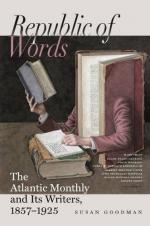A republic, in the midst of contending elements, the history of Florence, in the Middle Ages, was a history of what shoots and blossoms the Italian nature might send forth, when rooted in the rich soil of liberty. It was a city of poets and artists. Its statesmen, its merchants, its common artisans, and the very monks in its convents, were all pervaded by one spirit. The men of Florence in its best days were men of a large, grave, earnest mould. What the Puritans of New England wrought out with severest earnestness in their reasonings and their lives these early Puritans of Italy embodied in poetry, sculpture, and painting. They built their Cathedral and their Campanile, as the Jews of old built their Temple, with awe and religious fear, that they might thus express by costly and imperishable monuments their sense of God’s majesty and beauty. The modern traveller who visits the churches and convents of Florence, or the museums where are preserved the fading remains of its early religious Art, if he be a person of any sensibility, cannot fail to be affected with the intense gravity and earnestness which pervade them. They seem less to be paintings for the embellishment of life than eloquent picture-writing by which burning religious souls sought to preach the truths of the invisible world to the eye of the multitude. Through all the deficiencies of perspective, coloring, and outline incident to the childhood and early youth of Art, one feels the passionate purpose of some lofty soul to express ideas of patience, self-sacrifice, adoration, and aspiration far transcending the limits of mortal capability.
The angels and celestial beings of these grave old painters are as different from the fat little pink Cupids or lovely laughing children of Titian and Correggio as are the sermons of President Edwards from the love-songs of Tom Moore. These old seers of the pencil give you grave, radiant beings, strong as man, fine as woman, sweeping downward in lines of floating undulation, and seeming by the ease with which they remain poised in the air to feel none of that earthly attraction which draws material bodies earthward. Whether they wear the morning star on their forehead or bear the lily or the sword in their hand, there is still that suggestion of mystery and power about them, that air of dignity and repose, that speak the children of a nobler race than ours. One could well believe such a being might pass in his serene poised majesty of motion through the walls of a gross material dwelling without deranging one graceful fold of his swaying robe or unclasping the hands folded quietly on his bosom. Well has a modern master of art and style said of these old artists, “Many pictures are ostentatious exhibitions of the artist’s power of speech, the clear and vigorous elocution of useless and senseless words; while the earlier efforts of Giotto and Ciniabue are the burning messages of prophecy delivered by the stammering lips of infants.”




